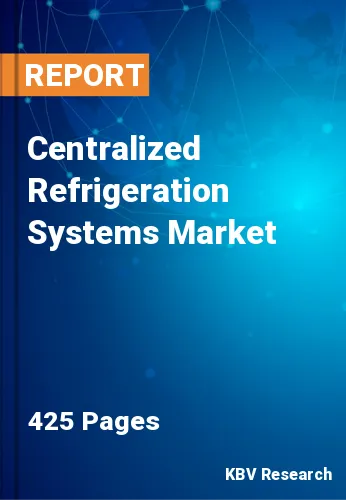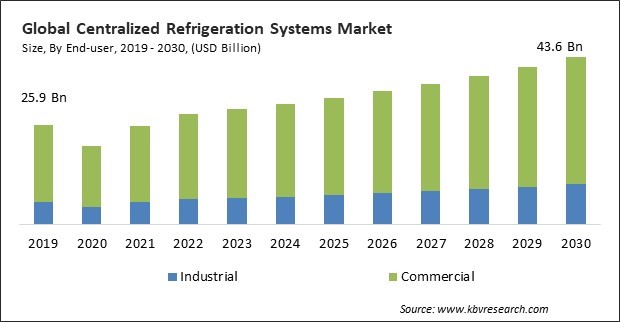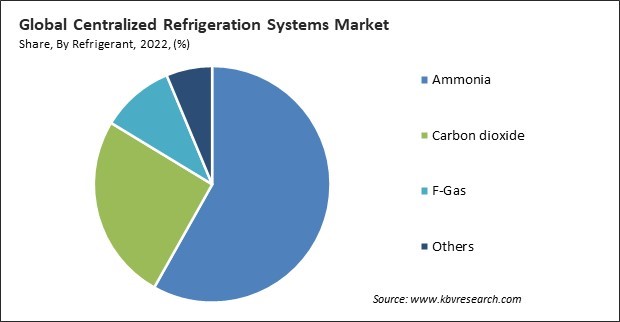
The Global Centralized Refrigeration Systems Market size is expected to reach $43.6 billion by 2030, rising at a market growth of 5.4% CAGR during the forecast period. In 2022, the market attained a volume of 35,14,799 Units experiencing a growth of 5.2% (2019-2022).
F-Gas refrigerants have been a focal point in the market due to their environmental impact and regulatory implications. Therefore, F-Gas segment captured a $2,898.1 million revenue in the market in 2022. These refrigerants, primarily hydrofluorocarbons (HFCs), have a high global warming potential (GWP), contributing significantly to climate change when released into the atmosphere. As a result, there has been a concerted effort to phase out or reduce the use of F-Gas refrigerants in centralized refrigeration systems. Some of the factors affecting the market are rapid expansion of the food and beverages sector, technological advancements in centralized refrigeration and high initial and maintenance costs.

The global population's growing demand for food and beverages has led to increased production, storage, and distribution requirements. CRS is essential for preserving the quality and safety of perishable products, including fresh produce, dairy, meat, and frozen foods. Producing and storing beverages, including soft drinks, juices, and alcoholic beverages, require specialized refrigeration solutions. CRS systems are tailored to the specific needs of beverage manufacturers. The rise in the food and beverages industry substantially impacts the demand. Factors such as increasing consumption, food safety regulations, cold chain logistics, retail expansion, customization, energy efficiency, environmental concerns, technological advancements, food processing, pharmaceuticals, the beverage industry, and continuous innovation contribute to the growth within this sector. Additionally, New compressor designs, such as scroll and digital compressors, offer better efficiency and reliability than traditional reciprocating compressors. Digital compressors modulate capacity very efficiently, reducing energy consumption. Technological advancements collectively contribute to more sustainable, efficient, and reliable centralized refrigeration systems. As environmental concerns and energy efficiency standards evolve, further innovations will likely emerge, driving the growth of the market.
However, the upfront cost of purchasing and installing these systems can be substantial. This can be a substantial financial strain, particularly for small and medium-sized firms or organizations with limited resources. High energy consumption by inefficient or outdated centralized refrigeration systems results in elevated operating expenses. This ongoing cost strains the budgets of businesses, making it challenging to maintain profitability. Manufacturers and suppliers of these systems face the challenge of offering competitive pricing while maintaining product quality. The market has price-sensitive buyers who prioritize lower upfront costs over energy efficiency or advanced features.
On the basis of end-user, the market is divided into commercial and industrial. In 2022, the industrial segment garnered a significant revenue share in the market. The expansion of the industrial CRS is expanded by factors like the development of the manufacturing sector, the demand for temperature-controlled solutions in chemicals and pharmaceuticals, the importance of waste heat recovery, environmental regulations, and a focus on resource conservation. As industrial processes become more sophisticated and demanding, the role of CRS in ensuring efficiency and reliability is increasingly significant. CRS plays a vital role in maintaining optimal conditions for these industries. As these sectors grow and evolve, there is a corresponding need for advanced and scalable centralized refrigeration systems.
Based on refrigerant, the market is classified into F-Gas, carbon dioxide, ammonia, and others. The carbon dioxide segment acquired a substantial revenue share in the market in 2022. CO2 is a natural refrigerant with a very low global warming potential (GWP) of 1, which makes it an environmentally friendly choice. Many industries and businesses seek to reduce their carbon footprint in light of worries regarding greenhouse gas emissions and climate change growth. The adoption of CO2 refrigeration systems aligns with these sustainability goals. The carbon dioxide segment is expected to grow in the market due to its environmental benefits, regulatory compliance, energy efficiency, cost savings potential, technological advancements, relevance in cold chain logistics, consumer preferences, and industry-wide efforts to promote sustainability.

By component, the market is categorized into compressors, controls, condensers, evaporators, and others. The compressors segment covered a considerable revenue share in the market in 2022. Compressors are at the heart of refrigeration systems, compressing and circulating refrigerant gases. Manufacturers are continuously developing more energy-efficient compressors to meet sustainability and regulatory requirements. High-efficiency compressors significantly reduce the energy consumption of centralized refrigeration systems, leading to cost savings for businesses and reducing their carbon footprint. As energy efficiency becomes a primary concern for many industries, adopting energy-efficient compressors drive market growth. As businesses increasingly prioritize sustainability and efficiency, innovative compressor solutions will remain a focal point for market expansion.
| Report Attribute | Details |
|---|---|
| Market size value in 2022 | USD 28.9 Billion |
| Market size forecast in 2030 | USD 43.6 Billion |
| Base Year | 2022 |
| Historical Period | 2019 to 2021 |
| Forecast Period | 2023 to 2030 |
| Revenue Growth Rate | CAGR of 5.4% from 2023 to 2030 |
| Number of Pages | 425 |
| Number of Table | 800 |
| Quantitative Data | Volume in Units, revenue in USD Million and CAGR from 2019 to 2030 |
| Report coverage | Market Trends, Revenue Estimation and Forecast, Segmentation Analysis, Regional and Country Breakdown, Companies Strategic Developments, Company Profiling |
| Segments covered | Refrigerant, Component, End-user, Region |
| Country scope | US, Canada, Mexico, Germany, UK, France, Russia, Spain, Italy, China, Japan, India, South Korea, Singapore, Malaysia, Brazil, Argentina, UAE, Saudi Arabia, South Africa, Nigeria |
| Growth Drivers |
|
| Restraints |
|
Region-wise, the market is analysed across North America, Europe, Asia Pacific, and LAMEA. In 2022, the Asia Pacific region led the market by generating the highest revenue share. The APAC region contains some of the world's fastest-growing economies, such as China, India, and Southeast Asian nations. As these economies expand, there is an increased demand for cold storage and refrigeration solutions to support various industries such as food and beverage, pharmaceuticals, and logistics. Rapid urbanization in APAC countries has led to many supermarkets, hypermarkets, convenience stores, and restaurants. These retail and food service establishments rely on CRS for refrigeration and storage, contributing to market growth. The market expansion in this region is driven by changing consumer habits, urbanization, food safety regulations, the growth of pharmaceutical and healthcare sectors, the expansion of the cold chain, environmental concerns, government initiatives, technological advancements, infrastructure development, and healthcare awareness. As these trends continue, APAC's market is expected to remain robust and dynamic.
Free Valuable Insights: Global Centralized Refrigeration Systems Market size to reach USD 43.6 Billion by 2030
The market research report covers the analysis of key stakeholders of the market. Key companies profiled in the report include The Danfoss Group, Daikin Industries Ltd., Evapco, Inc., Carrier Global Corporation, GEA Group AG, Emerson Electric Co., Bitzer SE, Johnson Controls International PLC, Frigo Group and LU-VE S.p.A. (Finami S.R.L.)
By End-user (Volume, Units, USD Million, 2019-2030)
By Refrigerant (Volume, Units, USD Million, 2019-2030)
By Component
By Geography (Volume, Units, USD Million, 2019-2030)
This Market size is expected to reach $43.6 billion by 2030.
Rapid Expansion of Food and Beverages Sector are driving the Market in coming years, High Initial and Maintenance Cost restraints the growth of the Market.
The Danfoss Group, Daikin Industries Ltd., Evapco, Inc., Carrier Global Corporation, GEA Group AG, Emerson Electric Co., Bitzer SE, Johnson Controls International PLC, Frigo Group and LU-VE S.p.A. (Finami S.R.L.)
In 2022, the market attained a volume of 35,14,799 Units experiencing a growth of 5.2% (2019-2022).
The Ammonia segment is leading the Market by Refrigerant in 2022 achieving a market value of $24.5 billion by 2030.
The Asia Pacific region dominated the Market by Region in 2022 and would continue to be a dominant market till 2030; thereby, achieving a market value of $17.5 billion by 2030.
Our team of dedicated experts can provide you with attractive expansion opportunities for your business.
